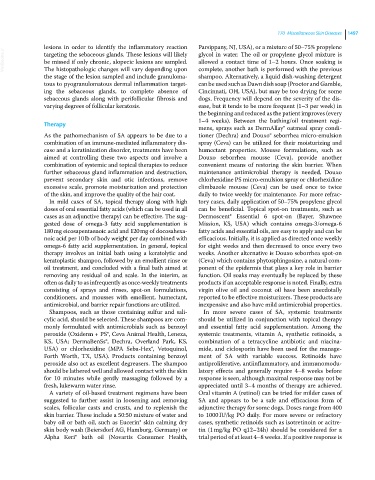Page 1559 - Clinical Small Animal Internal Medicine
P. 1559
170 Miscellaneous Skin Diseases 1497
lesions in order to identify the inflammatory reaction Parsippany, NJ, USA), or a mixture of 50–75% propylene
VetBooks.ir targeting the sebaceous glands. These lesions will likely glycol in water. The oil or propylene glycol mixture is
allowed a contact time of 1–2 hours. Once soaking is
be missed if only chronic, alopecic lesions are sampled.
The histopathologic changes will vary depending upon
shampoo. Alternatively, a liquid dish‐washing detergent
the stage of the lesion sampled and include granuloma- complete, another bath is performed with the previous
tous to pyogranulomatous dermal inflammation target- can be used such as Dawn dish soap (Proctor and Gamble,
ing the sebaceous glands, to complete absence of Cincinnati, OH, USA), but may be too drying for some
sebaceous glands along with perifollicular fibrosis and dogs. Frequency will depend on the severity of the dis-
varying degrees of follicular keratosis. ease, but it tends to be more frequent (1–3 per week) in
the beginning and reduced as the patient improves (every
1–4 weeks). Between the bathing/oil treatment regi-
Therapy
mens, sprays such as DermAllay® oatmeal spray condi-
As the pathomechanism of SA appears to be due to a tioner (Dechra) and Douxo® seborrhea micro‐emulsion
combination of an immune‐mediated inflammatory dis- spray (Ceva) can be utilized for their moisturizing and
ease and a keratinization disorder, treatments have been humectant properties. Mousse formulations, such as
aimed at controlling these two aspects and involve a Douxo seborrhea mousse (Ceva), provide another
combination of systemic and topical therapies to reduce convenient means of restoring the skin barrier. When
further sebaceous gland inflammation and destruction, maintenance antimicrobial therapy is needed, Douxo
prevent secondary skin and otic infections, remove chlorhexidine PS micro‐emulsion spray or chlorhexidine
excessive scale, promote moisturization and protection climbazole mousse (Ceva) can be used once to twice
of the skin, and improve the quality of the hair coat. daily to twice weekly for maintenance. For more refrac-
In mild cases of SA, topical therapy along with high tory cases, daily application of 50–75% propylene glycol
doses of oral essential fatty acids (which can be used in all can be beneficial. Topical spot‐on treatments, such as
cases as an adjunctive therapy) can be effective. The sug- Dermoscent® Essential 6 spot‐on (Bayer, Shawnee
gested dose of omega‐3 fatty acid supplementation is Mission, KS, USA) which contains omega‐3/omega‐6
180 mg eicosapentaenoic acid and 120 mg of docosahexa- fatty acids and essential oils, are easy to apply and can be
noic acid per 10 lb of body weight per day combined with efficacious. Initially, it is applied as directed once weekly
omega‐6 fatty acid supplementation. In general, topical for eight weeks and then decreased to once every two
therapy involves an initial bath using a keratolytic and weeks. Another alternative is Douxo seborrhea spot‐on
keratoplastic shampoo, followed by an emollient rinse or (Ceva) which contains phytosphingosine, a natural com-
oil treatment, and concluded with a final bath aimed at ponent of the epidermis that plays a key role in barrier
removing any residual oil and scale. In the interim, as function. Oil soaks may eventually be replaced by these
often as daily to as infrequently as once‐weekly treatments products if an acceptable response is noted. Finally, extra
consisting of sprays and rinses, spot‐on formulations, virgin olive oil and coconut oil have been anecdotally
conditioners, and mousses with emollient, humectant, reported to be effective moisturizers. These products are
antimicrobial, and barrier repair functions are utilized. inexpensive and also have mild antimicrobial properties.
Shampoos, such as those containing sulfur and sali- In more severe cases of SA, systemic treatments
cylic acid, should be selected. These shampoos are com- should be utilized in conjunction with topical therapy
monly formulated with antimicrobials such as benzoyl and essential fatty acid supplementation. Among the
peroxide (Oxiderm + PS®, Ceva Animal Health, Lenexa, systemic treatments, vitamin A, synthetic retinoids, a
KS, USA; DermaBenSs®, Dechra, Overland Park, KS, combination of a tetracycline antibiotic and niacina-
USA) or chlorhexidine (MPA Seba‐Hex®, Vetoquinol, mide, and ciclosporin have been used for the manage-
Forth Worth, TX, USA). Products containing benzoyl ment of SA with variable success. Retinoids have
peroxide also act as excellent degreasers. The shampoo antiproliferative, antiinflammatory, and immunomodu-
should be lathered well and allowed contact with the skin latory effects and generally require 4–8 weeks before
for 10 minutes while gently massaging followed by a response is seen, although maximal response may not be
fresh, lukewarm water rinse. appreciated until 3–4 months of therapy are achieved.
A variety of oil‐based treatment regimens have been Oral vitamin A (retinol) can be tried for milder cases of
suggested to further assist in loosening and removing SA and appears to be a safe and efficacious form of
scales, follicular casts and crusts, and to replenish the adjunctive therapy for some dogs. Doses range from 400
skin barrier. These include a 50:50 mixture of water and to 1000 IU/kg PO daily. For more severe or refractory
baby oil or bath oil, such as Eucerin® skin calming dry cases, synthetic retinoids such as isotretinoin or acitre-
skin body wash (Beiersdorf AG, Hamburg, Germany) or tin (1 mg/kg PO q12–24h) should be considered for a
Alpha Keri® bath oil (Novartis Consumer Health, trial period of at least 4–8 weeks. If a positive response is

